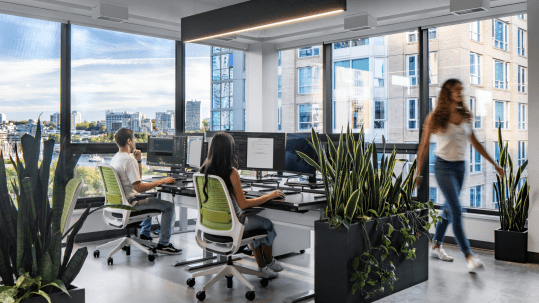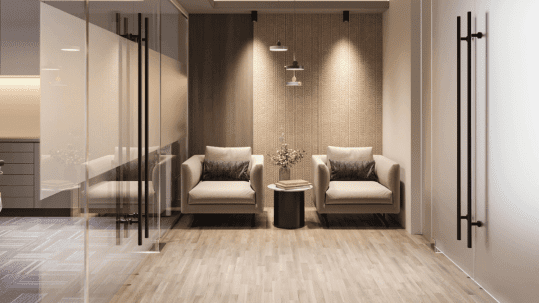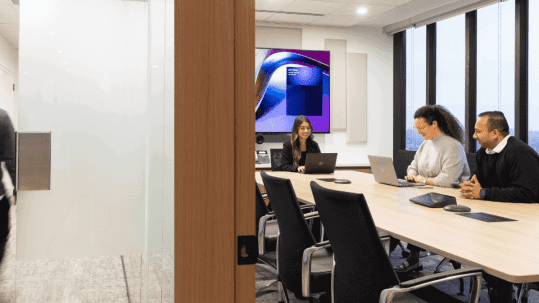With a vaccine now on the horizon, our “next normal” seems to be approaching very soon. Companies are eager to bring their staff back to the office, but what will that look like? Should things return to the way they were in the past? Will it be that simple now that the way we’ve worked may have changed forever? Or is the return to the office a much more strategic initiative than we thought?
To get some insight on how leaders are preparing for staff to return to work and what challenges they’re facing, on Wednesday, December 9th, 2020, we hosted our most recent Tenant Talks event. Panelists included representatives from accounting firms KPMG and E&Y in both Canadian and US-based offices, while Rocky Ozaki, Founder of Now of Work led the discussion.
Here’s what we learned about how firms in the accounting industry are navigating the disruptions of the pandemic and preparing for the future of their offices.
Prefer to watch the video recording? Watch here.
Q1 – What’s one significant change your company has made in response to COVID-19?
Three changes were discussed:
- Focusing on employee wellbeing more than ever before
- Downsizing and repurposing office spaces
- Transitioning to distributed workforces
Grace Paul, America’s Experience Leader of Real Estate Services at E&Y shared how E&Y now puts a renewed and focused effort into the mental, emotional, and physical wellbeing of its staff.
“We’ve done what we can to focus on staff’s wellbeing in a time that’s very challenging. And not just their fiscal wellbeing but their mental wellbeing as well,” said Grace.
E&Y has expanded its WFH stipends to cover office equipment like standing desks and whatever else is needed to ensure employees are comfortable to do their jobs. They’ve also offered discounts on healthy food deliveries. Some teams have even changed up some of their meetings to outdoor walking meetings to give teams a chance to reconnect and get some fresh air in between their focus tasks.
David Hearn, Regional Real Estate Services Leader at E&Y said his company is looking at less office space, and for that space to be more of a collaborative space that still adheres to social distancing.
“You’re no longer going to come into the office from 9-5,” he said, “It’s a purpose-driven environment. If you’ve got a meeting, you come in, and do what you gotta do and head out.”
Walter Pela, GVA Regional Managing Partner at KPMG Canada, jumped in to discuss the accelerated pace in which organizations have adopted flexible and remote working arrangements. He expressed that despite the adverse context in which all of this has happened, the silver lining was that his firm discovered it’s ability to embrace flexible working. “This seismic shift has accelerated what was going to happen in the next 5-10 years into a very short window of time,” said Walter.
He also spoke about the essential strategy that is needed before a hybrid model can succeed.
“This can’t be the new normal. We need to figure out how to create a hybrid model both from a workplace strategy and physical workspace point of view, in a way that gives employees the benefits of both worlds.”
Q2 – How has your organization dealt with the “fatigue” or burnout that many are experiencing as the result of the pandemic? How are you re-energizing your organizational culture?
Panelists discussed similar approaches:
- Increasing the frequency of meetings and intentional pulse-checks
- Making more explicit efforts towards mental health
- Adopting empathetic, no-judgement approaches to how people are showing up for work
Speakers discussed their similar experience in how fatigue has come as a result of lack of physical connection, a slowed speed of communication, and fewer hands-on mentorship opportunities as employees work from home.
David at EY took pride in how his leadership team has made the most of technology to make noticeable, intentional efforts to check in on staff wellbeing on a weekly basis. The firm has seen a reduction in monthly company-wide and an increase in smaller, more meaningful meetings. “Thanks to technology, we have lots of team calls to check in. We feel more connected than we ever were before, even if that’s over video,” said David.
Grace at E&Y shared how her leadership team has taken a no-judgement approach to how people are showing up to work.
People are bringing their real selves to work, and they’re not always as made up as they used to be. The work-self and the personal-self have become more blurred. “The longer people were in their circumstances, the more they felt at liberty to be themselves,” she said, “We’ve been making sure we find ways to support the team empathetically and understand that not everyone’s circumstances are the same or comfortable.”
Not expecting employees to be tied to a specific location, the team has kept arrangements quite flexible to support those who needed to move back home or be with their aging parents.
Walter at KPMG agreed that teams are touching base more often than they would before. He has seen the same happen with his company’s global people surveys that would traditionally only be done once a year. They are now sent out much more frequently to assess employee sentiments more often.
He highlighted his firm’s explicit and deliberate focus on mental health by appointing a Chief Mental Health Officer. “Our Chief Mental Health officer’s sole purpose is to amplify the message and acceptability of mental health as something we talk about in the firm,” he said, “Together, we work on noticing symptoms of struggling mental health and coming up with a game plan of what to do around them.”
Q3 – As we look to, and plan for a year from now (assuming a vaccine being widely available and effective) what purpose will your physical office fulfill? What might it look like – what can or can’t change?
These four themes emerged:
- How real estate will be used is going to transition away from the idea of packing employees per square foot
- Offices are going to move to more people-based and social designs
- We will see greater investments in technology for more effective collisions
Employees will start to become much more efficient with their in-office days
Walter at KPMG stated that although the office remains the anchor to businesses, people are the biggest asset. He discussed how design will and is already changing towards people-based design and use of the space.
He shared his observations that people don’t want to exclusively come into the office or exclusively stay at home. On average, employees will want the flexibility to come in when they want to, but not have to be there.
“Space is no longer based on intensity or how many people you can pack per square foot. That has shifted greatly,” he said, “We need to offer a variety of mind space.”
David at EY expects the office experience to change in a couple of ways:
Office days will be much more focused and more efficient.
Employes will want to avoid the commute times and parking costs of coming in a few days a week, so they’ll be making their best efforts to be a lot more efficient with their time.
“If you knew you had to go into the office one day a week, you’d plan that day extremely well,” he said.
Investment in technology is going to increase.
Leadership will be making bigger efforts to make sure people are enjoying their environment while they’re there.
Grace at E&Y stated that there is a direct correlation between people’s commute times and their willingness to be in office. She expects that this will play a big factor when it comes to the hybrid working model. She agreed that days in office will become a lot more intentional.
She as well as the rest of the panel brought up their concerns around how leadership is going to blend the physical and the digital in the future.
“How do you make sure that there is equal participation from those who aren’t in the office?,” said Rocky, “What happens to those who don’t have as much face time if they prefer to work remotely?”
Panelists agreed on leadership’s critical role in ensuring equality as we bridge the physical and the digital in the future office.
Q4 – What are examples of approaches to bringing staff back into the office? Does your organization have any safety measures put in place for both physical and mental well being for welcoming staff back to the office?
Three approaches were mentioned:
- Creating and clearly communicating health and safety policies
- Working closely with building landlords to understand and match policies
- Relying on technology to ensure social distancing
Grace at E&Y mentioned her firm’s tactical efforts to ensure the health and safety of staff, like measuring indoor air quality, ramping up cleaning protocols, and introducing self-certification apps.
She stressed how important it is to make sure changes and expectations are clearly communicated and well understood. “You need to make sure that people understand that the measures in place are intentional and consistent,” she said, “People need to know what to expect and how to use the technology.”
David at EY shared how EY has implemented a 4-level system that determines the percentage of staff leadership is allowed to bring in, 100%, 50%, 25% or 10%. The rule is that leadership making this request for staff to come in must also be present on those days.
He mentioned that leadership has to be mindful of the employee experience if their employees are coming back to work while the rest of the community remains locked down. Whether food courts and restaurants are open needs to be considered to ensure staff are comfortable to do their jobs and have their needs met.
David highlighted how EY has worked closely with its whole ecosystem to ensure they understand building protocols. “We’ve worked closely with landlords to make sure our safety protocols match what the building is doing,” he said, “If landlords only allow 3 people in an elevator at one time, then we can expect to see lineups in the lobby and on our floors. We need to make sure we work with that schedule and understand and match their intentions.”
Walter at KPMG discussed how his team intends to remain socially distant by keeping communication digital and meetings virtual wherever possible. Panelists also shared some of the benefits of digital meetings. “The screen is a great equalizer,” said Walter “It’s hard to dominate team calls when everyone gets the same space on a screen.”
As always our Tenant Talks events end off with a round of rapid-fire questions. Here’s what our panelists had to say.
What are you most fearful of moving into 2021 in regards to the working environment?
“The liability of office space out there that’s not going to be used,” said David
“Failing to seize the moment, going back to the same old,” said Grace
“We don’t want to get complacent and be back where we were after the pandemic has been managed. We don’t want to go back to our old ways,” said Walter.
What’s the biggest surprise/learning you’ve gained from this COVID experience?
“Remote working proof of concept, confirmed,” said Grace
“Our resilience and ability to work remotely,” said Walter
“Resilience across the board, from landlords to staff, clients, everybody,” said David
What is the one golden nugget of advice you’d like to share about the future of office design and experience?
“Design and experience are going to matter more than ever. You’ll want to be the employer of choice and location of choice,” said Grace
“The environment is purpose-driven, you come in, do what you have to do, and it makes people a heck of a lot more efficient,” said David
“Being able to plan for a post-pandemic situation. What does the hybrid future look like? We have an opportunity, a window, to plan for it now,” said Walter
We thank all our panelists and attendees for joining us on this fruitful discussion on the importance of workplace strategy for the future of our offices.
Join the Tenant Talks mailing list to be the first to know about our next event.
For assistance with your workplace strategy as you prepare your workforce for its return to work, book a free consultation with Aura.






